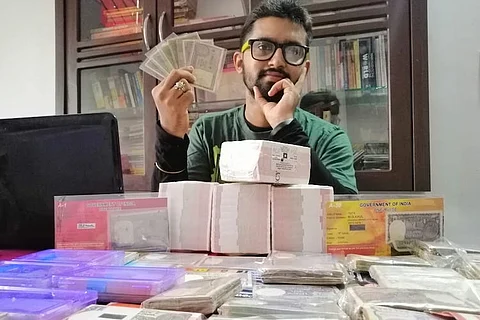

Arvind Kumar Pai, a primary school teacher from Cherthala in Kerala, is a self-confessed philatelist, or a person who loves stamps. The 33-year-old who teaches English and Science at a government school claims to have the largest collection of Gandhi stamps in the country at over 8000. He is also a Limca Book of Records record holder for affixing the most number of stamps on an envelope – he fixed 322 stamps on the envelope in which he sent a letter he sent to his mother in 2014.
But stamps are not all that he collects. In fact, he didn’t immediately realise that he had ended up collecting 500 one-rupee notes in his stash. And when he did, he decided to make a record out of it. And so, in 2018, Arvind became a record-holder in the Limca book as well as Best of India records for having the largest collection of one-rupee notes issued in independent India – a unique total of 11,111 – and having collected a minimum of three notes per year.
One rupee note signed by KRK Menon
“I had a sizeable number when I started and around 2007. I realised that I wanted to complete my collection,” begins Arvind, before he shares some interesting facts about the one-rupee note.
“Unlike every other currency printed in India, the one-rupee note is printed by Government of India and not the RBI. So it is called the Government of India note. This is printed at the Security Printing and Minting Corporation of India Ltd (SPMCIL). Also, it does not have the statement “I promise to pay the bearer...” that you find on other notes,” he shares.
Moreover, the one-rupee note is signed by the Finance Secretary, and not the RBI Governor like other currency notes. “In my collection, I was short of notes signed by two Finance Secretaries. They were rare, and hard to find. I had to pay quite a hefty amount to complete my collection. I also exchanged some of my stamps to procure them,” he adds.
The highest Arvind paid to add a coveted one-rupee note to his collection was Rs 10,000, just a few years ago, for a rare 1964 note signed by then Finance Secretary S Bhoothalingam. He obtained it from a collector in Chennai.
Arvind reveals that the one-rupee note has gone through many transformations, and has an interesting history too. The first Indian one-rupee note was printed in the year 1917, mainly as an alternative to the scarcity of metal faced by the colonial government to mint coins: a consequence of World War I. The first one-rupee note, printed on November 30, 1917, in England had a silver coin image of King George V on its top left corner. This note was then discontinued along with other small-value notes such as the exotic Rs 2 and eight annas on January 1, 1926, mainly on cost-benefit considerations. However, they were reintroduced in 1940.
In independent India, the Re 1 note was first printed on August 12, 1949, making this year its 70th anniversary. This note too was eventually stopped in 1994. Finance Secretary KRK Menon had signed the 1949 notes, and when they were stopped in 1994, the notes bore Montek Singh Ahluwalia’s signature.
“In 2015, Prime Minister Narendra Modi announced that the notes would be printed once again, but in limited quantities. But it wasn’t printed for nearly two decades before 2015,” observes Arvind, who has notes from 1949 (KRK Menon) to 2018 (Subhash Chandra Garg).
“The note that was printed in 2018 is the only note that has the year ‘2018’ printed vertically. Every other note has this in horizontal. No one has noticed it; you won’t find any news report on it. It is the first of its kind,” Arvind shares, like one would, a top secret.
2018 printed vertically on the one rupee note
“Also, the first note that was printed on August 12, 1949 is the only note that does not have the stapler mark on it. Every other note does. After 1949, unstapled notes were back only after 2015. So that one note from 1949 is special,” he adds furtively.
The young enthusiastic collector is now collecting notes bearing serial numbers that match with important dates in Indian history. “For instance, this note that has serial number 120849 is special because it is the date when it was first printed – August 12, 1949. It would be a record to tell India’s history through these notes,” his voice barely contains his excitement.
One rupee note with a serial number that incicates thatdate it was first printed - August 12, 1949
Ask Arvind the mantra behind his passion for collecting, and he reveals, “I was bullied in school for being poor in academics. Holding these records now, is my achievement, my way of proving my bullies wrong.”